By Alex Trukan
When playing against 4-3-3 one of the first thoughts is how to prevent the opposition from dominating centre of the pitch. Especially when the opposition plays with narrow wingers and relies on full backs in wide areas, the biggest danger is centre of the pitch. One of the systems of play that overload central areas is 5-3-2. Effectively, there are 8 players positioned within central area of the pitch that can potentially stop the opposition from playing through. This article describes some of the aspects of defending in 5-3-2 when playing against narrow 4-3-3 formation.
First defending block starts with front two players who stay within central zones, slide and screen to prevent forward passes. It is important that these two players don’t go and press full backs as that will create gaps in the middle and open up spaces to play through centre midfielders. The main role is to prevent passes into defensive midfielders and recognise triggers to go and press centre backs. If one of the strikers decides to go and press the ball, the other one should come on a different angle and offer support from behind. Both strikers should be patient and don’t get caught in unbalanced position too far apart from each other.
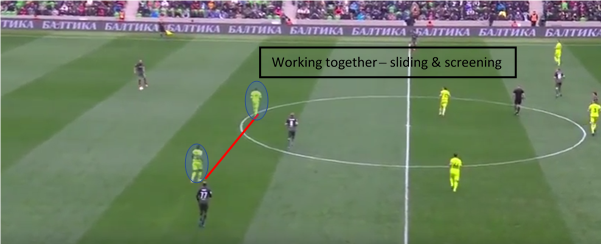
As soon as the ball is played into full back, it is the role of the wing back to engage and apply pressure from inside. This should deny any opportunities for a full back to play forwards. Three central midfielders slide across to mark central midfielders. One of the striker might decide to cut off the option into defensive midfielder, whereas second striker stays wider in case the ball is recycled. If the ball is played backwards into centre backs, the picture returns to the original situation with organised strikers’ unit sliding and screening.
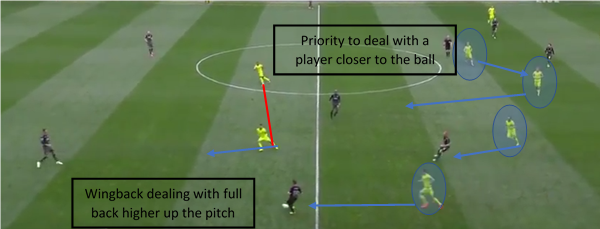
If the ball is played through the strikers’ unit and opposition midfielder gets on the ball to play forwards, the remaining 8 players behind the ball should stay compact and deny opportunities to play thorugh the middle as a priority. On the diagram below, we can see midfield three playing within small distances from each other in a triangle with a point down. First two centre midfielders are ready to apply pressure on the ball and screen passes into two opposition’s forwards playing in half spaces. The spare defensive midfielder offers suport from the back and screens the pass into central striker. Right and left centre backs are ready to apply pressure and prevent turns if the ball is played into opposition strikers in half spaces. The remaining centre back deals with number 9.
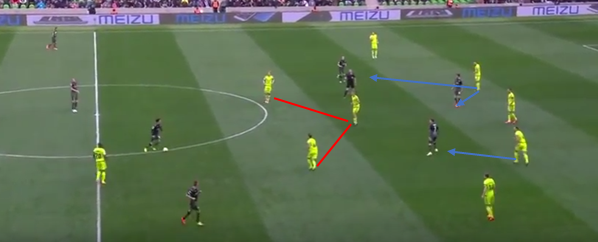
On the diagram below we can see how left centre back steps up to prevent opposition forward from getting on the ball. Spare centre back is ready to deal with any forward runs as he allowed extra yard in front of him giving him time to react. This shape leaves the opposition with options to play out wide and recycle the ball away from the goal.
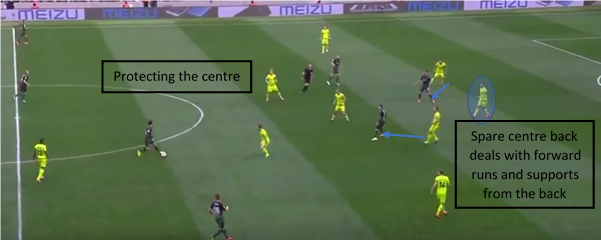
Having three centre backs gives the team another advantage when the ball is in wide areas. As the opposition plays with narrow 4-3-3, their right and left forwards would be looking to make runs into half spaces between full back and centre back (if they were playing against back four). Having wingbacks and three centre backs provides a team with an option to cover those half spaces and track any runners by having right/left centre back there. This happens without losing protection in central areas as two other centre backs supported by opposite wing back will be there.
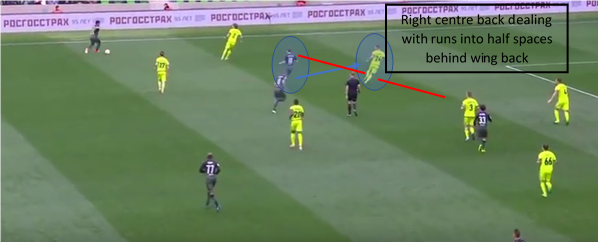
One important requirement when defending in this strategy is having wingbacks which are very good in defending 1v1 duels. This will prevent the opposition going around the block and creating overload in wide areas. Winning the ball in those areas can also offer important moment to start the counter attack as the opposition full back might be behind the ball.
By Alex Trukan, Development Coach, Nottingham Forest - @AlexTrukan


